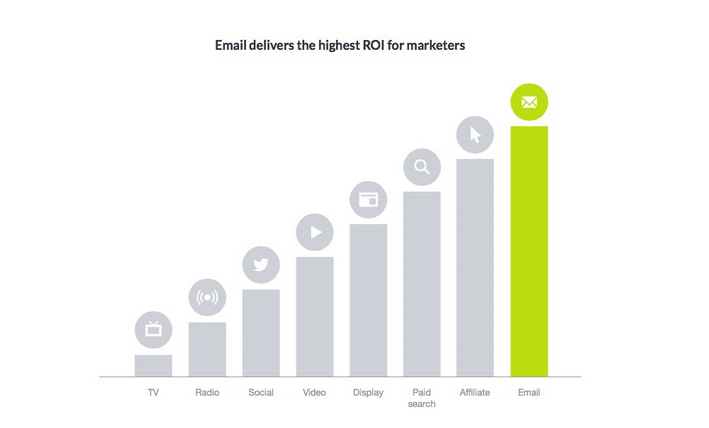Today there’s a lot of emphasis on the power of social media, marketers can sometimes forget to step back a decade and remember the tactics that used to work for them.
10 years ago, before Facebook exploded and the subsequent flurry of Twitter, Google+, Pinterest and all the rest – online marketing was either done via paid advertising on websites and search engines or via email.
Today, the trend seems to be all about blogs and social media. There’s a good reason for this of course. Even your grandma has a Facebook account right? Right. She plus, 1.44 billion others as the char below states from statista.com indicates.
With the rise of social media, brand have shifted their focus towards these platforms in an effort to promote awareness of their existence.
And it has worked.
Any new startup that thinks it can make it in the wave of the modern world without a website is honestly quite mad. An online presence these days is essential and can’t be avoided. With the mandates of Google’s search algorithms, if your website isn’t continuously being rejuvenated with streams of fresh content, then you will be thrown by the wayside and not be discoverable. This has given away to content marketing – aka blogging. A blog means that your website will have to have fresh content regularly and keep those Google bots well-fed and happy.
And blogging, in turn, has paved the way for social media marketing. Your blog is only ever as good as the amount of people that read it, and the amount of traffic it drives to your site — and social networks have proven to be the best platforms to deliver such content.
A very important distinction
Ok, I understand you’re thinking – this blog post is supposed to be about email marketing, not content or social media marketing.
You’ve got that right, of course. But please let me now reveal my conceit for starting off in such a manner.
Content marketing and social media marketing are all about raising brand awareness. These are tools that people use to get their business noticed by millions and billions of people who are out there on the web. They are used to drive traffic to a company’s website, to get people to think about them, how the business in question is involved, and how the business is positioned within the industry.
What makes content marketing and social media marketing is not, however, is a primary means of making sales, peddling products, and seeing big, direct, monetary returns on the marketer’s efforts.
Content marketing, indeed, is much more subtle art than that. Yes, it’s about making conversions, but those conversions are more about attaining subscribers than making sales.
But once you’ve got those subscribers, then it’s onto your email campaign to start earning you the ROI for your online marketing efforts.
Email Marketing reigns supreme
From research from Campaign Monitor find that “Even with the explosion of new technology, marketers keep coming back to email. The reason is clear – for ten years in a row, email is the channel of generating the highest ROI for marketings. For every $1 spent, email marketing generates $38 in ROI.”
Social media marketing appears proliferate, and no doubt you will be dedicating an awful lot of time trying to gain followers and generate meaningful leads. But, when it comes down to acquiring new paying customers, email wins the race every time. 40 times over in fact:
“Email is 40 times more effective at acquiring new customers than Facebook or Twitter.”
With all this in mind, you need to make sure that your email marketing campaign is on point every time. So below is some tips to help you get the most out of your efforts.
Email marketing tips:
- Think about the rise in mobile use
A survey conducted by BlueHornet has revealed that if email is not optimized for mobile, over 80% of recipients delete it and another 30% unsubscribe. Additionally, over 63% of consumers are interested to make a purchase if they find an email that looks good on their mobile device.
Over the last 5 years, email opens on mobile devices have increased by 30%. That’s an incredible amount in such a short time. No longer are people checking their email on a desktop while sat at the office desk. With the explosion of smartphones, people now check their emails long before the work day starts, either as soon as they reach for their phone in the morning or while on the commute to work.
Therefore, designing email for mobile is no longer a “nice-to-have feature” – it’s imperative.
- Personalization
This is the age of targeting and personalization, and your emails need to be on point with this. COnsumers expect to be addressed by their first names, and for the brands that they’re doing business with to know exactly who they are.
Furthermore, they want to be provided with specific content that has been targeted towards them. One size definitely doesn’t fit all when it comes to email marketing.
- Segmentation
One last point. As an extension of a previous topic, it should be noted that segmenting your email list into specific groups of subscribers can increase your open rate significantly. We’ve even noticed this that PlanPlus Online by taking lists of our real estate customers, and organizing the subscribers into lists of where they are from. This allows us smaller list groups to analyze, but also we can target them based on their region and what is going on with them based on where they live.
Let’s dive into some information from Campaign Monitor once more:
- 74% of online consumers cite frustration when content (i.e. offers, ads, promotions) appear to have nothing whatsoever to do with their interests
- 75% of enterprises will be investing in personalized messaging in 2015
- Segmented campaigns drive a 760% increase in revenue.
That last stat alone should be enough to convince you of the power of segmented email campaigns. You need to segment your subscribers into demographic groups (like I mentioned we do with some of our subscribers), and also groups defined by their purchase history and browsing activity. Using this information, you will be able to tailor all of your email messages to very specific types of subscribers, and if done well, achieve that 760% increase in revenue from your efforts as a result.
How effective are your email campaigns? What advice would you give to our readers? Let us know in the comments below!










